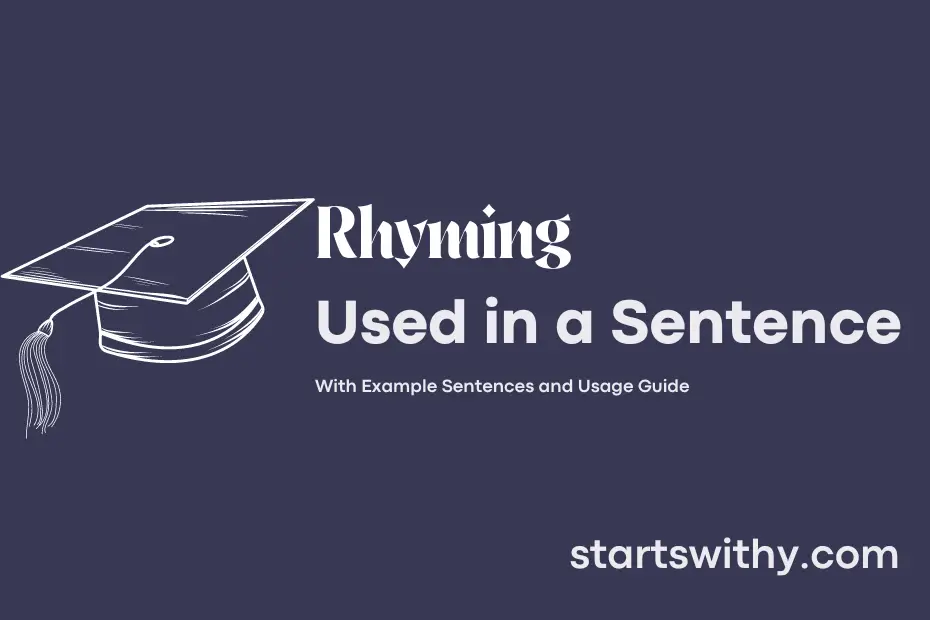Do you enjoy words that sound the same at the end? That’s rhyming! In poetry, songs, and even everyday speech, rhyming adds a pleasing musical quality to language.
Rhyming occurs when words share similar sounds at the end, creating a pattern that can be structured or freeform. This literary device is commonly used to enhance the flow of writing, create memorable phrases, or evoke a sense of rhythm in a piece of text.
7 Examples Of Rhyming Used In a Sentence For Kids
- Look at that cat, wearing a hat.
- The sun is high in the sky, as the birds fly.
- In the garden, I saw a frog, sitting on a log.
- I have a ball, let’s play some volleyball.
- The bee is buzz, collecting nectar it does.
- I see a kite, flying so high and so bright.
- With a pen in hand, I write on the sand.
14 Sentences with Rhyming Examples
- Rhyming can be a fun way to enhance your vocabulary.
- Many college students enjoy rhyming while writing poems or songs.
- Tired of studying? Take a break and engage in some rhyming games with your friends.
- You can join a rhyming club on campus to meet like-minded individuals.
- Adding rhyming words to your presentations can make them more engaging.
- Don’t underestimate the power of rhyming in helping you remember important information.
- Is it possible to learn a new language through rhyming exercises? Give it a try!
- Rhyming can also be used as a creative outlet for expressing your emotions.
- College students often use rhyming as a study aid to memorize complex concepts.
- Remember to incorporate rhyming techniques in your speeches to keep your audience engaged.
- Are you interested in entering a rhyming competition? It could be a thrilling experience.
- Rhyming can be a helpful tool for improving your communication skills.
- Next time you’re stuck on a difficult assignment, try rhyming to get your creative juices flowing.
- Don’t be afraid to experiment with different rhyming patterns in your writing projects.
How To Use Rhyming in Sentences?
Rhyming is the repetition of similar sounds in two or more words, typically at the end of the words. It is commonly used in poetry, song lyrics, and even in everyday language to add a musical quality to the text.
To use Rhyming in a sentence, first, identify the main word that you want to rhyme with. For example, if you want to rhyme with the word “cat,” think of words that end with the same sound, such as “hat” or “mat.”
Next, construct your sentence using the main word and the rhyme. For example, “The cat sat on the mat.”
Remember that the rhyming words should sound similar, but they don’t have to be spelled the same. For instance, “fun” can rhyme with “run” even though they are spelled differently.
Experiment with different words and sounds to create interesting and engaging rhymes. You can also try using internal rhyme, where the rhyming words appear within the same line, to add depth to your writing.
Practice using Rhyming in sentences by writing short poems or rhymes. Have fun exploring different words and sounds to see how they can enhance your writing and make it more memorable.
Conclusion
In this article, we explored the concept of creating sentences with rhyming words to add a playful and melodic touch to language. Rhyming sentences not only enhance the fluidity and rhythm of writing but also make it more pleasant to read and easier to remember. By incorporating rhymes into sentences, writers can engage readers and create a more enjoyable reading experience.
Using rhyming words creatively can bring poetry, songs, and storytelling to life, injecting a sense of artistry and whimsy into the written word. Whether it’s for educational purposes, entertainment, or simply to spark creativity, practicing the art of crafting sentences with rhyming words can be a fun and enriching linguistic exercise that can elevate the impact of written communication.



